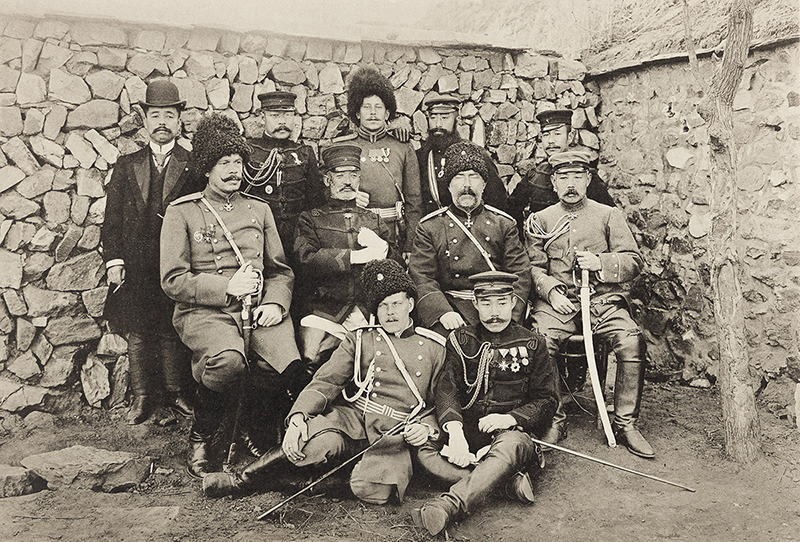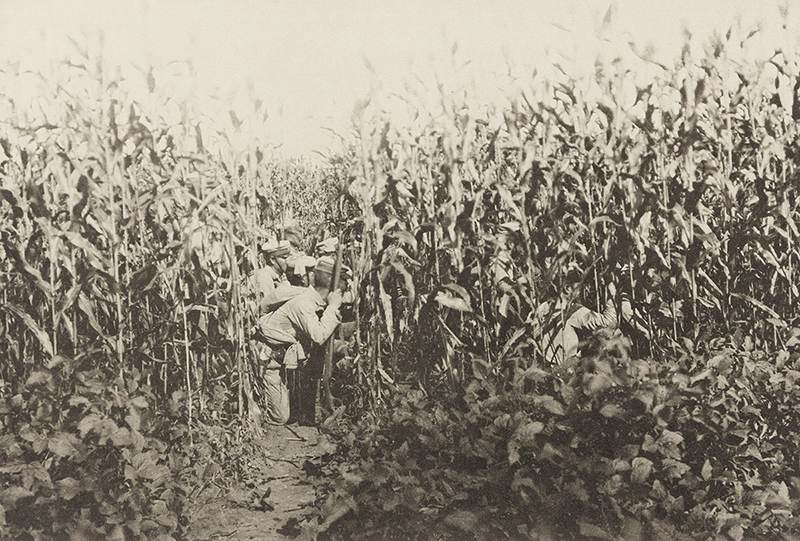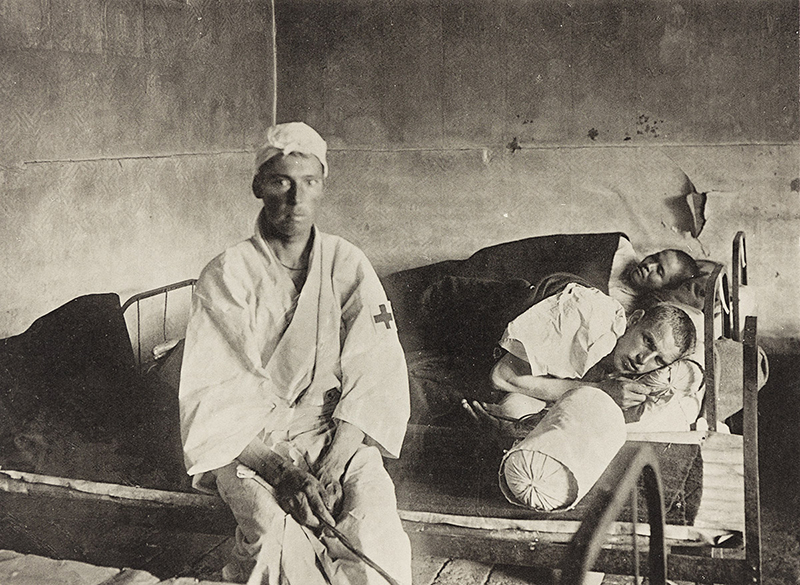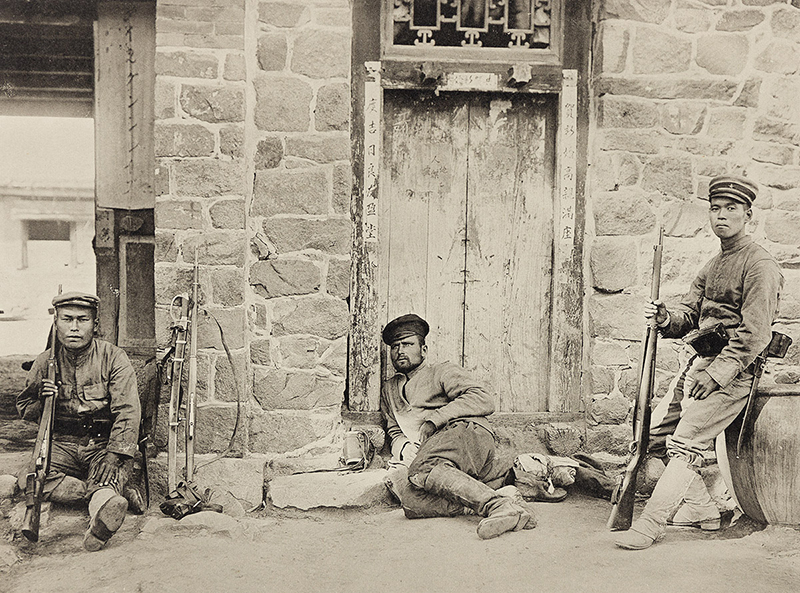Objects of the Month: A selection of approximately 95 photogravures from three folios depicting the Russo-Japanese War, 1904–1905, by Ogawa Kazumasa
By Bowdoin College Museum of Art
The Bowdoin College Museum of Art has recently acquired a stunning set of ninety-five photogravures that depict episodes from the Russo-Japanese War of 1904–1905. The series comprises three folios, which are only part of a larger twenty-three-folio set produced by the studio of Ogawa Kazumasa (1860–1929). This large-scale photographic project enables a detailed and multifaceted examination of the Russo-Japanese War—albeit from a certainly biased viewpoint—including portraits of officers, scenes from field hospitals, prisoners of war, exploding cannon-fire, and troops on campaign. These works constitute the first objects in the BCMA’s collection to represent the globally significant conflict between the Russian and Japanese empires, two expansionist powers who sought to establish control in Manchuria and the Korean peninsula as well as in the Yellow Sea and the Sea of Japan. The war ended in a major land and naval victory for the Empire of Japan over its Eurasian opponent. Nevertheless, the concluding treaty negotiations, overseen by United States President Theodore Roosevelt in Portsmouth, New Hampshire, yielded a far less desirable outcome than the Japanese delegation, government, and populace expected and have been linked to growing anti-American sentiment in Japan at the time.
 The photogravures have a complicated status as one of the most extensive photographic documentations of a war with far-reaching geopolitical consequences and a prime example of the nationalistic uses of photography during this period. Ogawa’s first professional foray into the genre of war photography was a project to document the Sino-Japanese War of 1894–1895, which met with limited success due to skepticism among military leadership. During the war with Russia a decade later, however, the Japanese ministry of war evidently realized the pictorial and propagandistic importance of photography in documenting and broadcasting their military successes. Significantly, the preface and individual image captions of Ogawa’s folios are printed in English, suggesting that the volumes were created with Anglophone rather than Japanese or Russian audiences in view. The images have since been removed from their original binding and mounted as individual sheets, with their captions pasted on the backs of the mounts.
The photogravures have a complicated status as one of the most extensive photographic documentations of a war with far-reaching geopolitical consequences and a prime example of the nationalistic uses of photography during this period. Ogawa’s first professional foray into the genre of war photography was a project to document the Sino-Japanese War of 1894–1895, which met with limited success due to skepticism among military leadership. During the war with Russia a decade later, however, the Japanese ministry of war evidently realized the pictorial and propagandistic importance of photography in documenting and broadcasting their military successes. Significantly, the preface and individual image captions of Ogawa’s folios are printed in English, suggesting that the volumes were created with Anglophone rather than Japanese or Russian audiences in view. The images have since been removed from their original binding and mounted as individual sheets, with their captions pasted on the backs of the mounts.
 Ogawa was a pathbreaking printer and publisher as well as Japan’s preeminent war photographer form the turn of the twentieth century. Born in the Oshi domain (current-day Saitama Prefecture) to a samurai family of the Matsudaira daimyo, Ogawa had studied both photography and English starting in his teenage years. In his early twenties, he lived between Tokyo and Boston, finally settling in the Japanese capital in 1884 and establishing his own photography studio there. He subsequently founded a dry-plate manufacturing company and distinguished himself as a pioneer of photomechanical printing techniques, including photogravure, among a print culture then dominated by woodblock and lithography. Ogawa was one of the fifty-six founding members of the Tokyo-based Japan Photographic Society, which existed from 1889 until 1896. He also served as an editor for Shashin Shinpō (Photography Journal) and Japan’s first mass-produced magazine Kokka, the latter of which frequently included works by the Japan Photographic Society. Other accolades include being named a fellow of the Royal Photographic Society of England, a member of the Japanese Imperial Art Academy, and a member of the imperial Order of the Rising Sun. Ogawa’s prolific oeuvre includes botanical studies, portraits, and depictions of rural life in Japan and China. Examples of these are in the collection of Bowdoin Library.
Ogawa was a pathbreaking printer and publisher as well as Japan’s preeminent war photographer form the turn of the twentieth century. Born in the Oshi domain (current-day Saitama Prefecture) to a samurai family of the Matsudaira daimyo, Ogawa had studied both photography and English starting in his teenage years. In his early twenties, he lived between Tokyo and Boston, finally settling in the Japanese capital in 1884 and establishing his own photography studio there. He subsequently founded a dry-plate manufacturing company and distinguished himself as a pioneer of photomechanical printing techniques, including photogravure, among a print culture then dominated by woodblock and lithography. Ogawa was one of the fifty-six founding members of the Tokyo-based Japan Photographic Society, which existed from 1889 until 1896. He also served as an editor for Shashin Shinpō (Photography Journal) and Japan’s first mass-produced magazine Kokka, the latter of which frequently included works by the Japan Photographic Society. Other accolades include being named a fellow of the Royal Photographic Society of England, a member of the Japanese Imperial Art Academy, and a member of the imperial Order of the Rising Sun. Ogawa’s prolific oeuvre includes botanical studies, portraits, and depictions of rural life in Japan and China. Examples of these are in the collection of Bowdoin Library.
 This acquisition greatly expands the BCMA’s collection of martial visual culture from the long nineteenth century, including war photography, which at present houses works by well-known British and American photographers such as Roger Fenton, Timothy O’Sullivan, and Alexander Gardner. Along with another recent acquisition, Uchida Kuichi’s albumen print Portrait of Empress Consort Haruko (1872), this series of photogravures also strengthens the BCMA’s holdings of works by Japanese photographers whose careers were tied to the technological, economic, military, and colonial expansion underway since the Meiji Restoration of 1868. It is hoped, therefore, that these new acquisitions will contribute to courses at Bowdoin College on globalization and imperialism in the early modern and modern periods. They also offer explorations into the global history and proliferation of means of photomechanical reproduction, especially in the mass press, examples of which feature less prominently in museum and private collections centered on fine-art photography.
This acquisition greatly expands the BCMA’s collection of martial visual culture from the long nineteenth century, including war photography, which at present houses works by well-known British and American photographers such as Roger Fenton, Timothy O’Sullivan, and Alexander Gardner. Along with another recent acquisition, Uchida Kuichi’s albumen print Portrait of Empress Consort Haruko (1872), this series of photogravures also strengthens the BCMA’s holdings of works by Japanese photographers whose careers were tied to the technological, economic, military, and colonial expansion underway since the Meiji Restoration of 1868. It is hoped, therefore, that these new acquisitions will contribute to courses at Bowdoin College on globalization and imperialism in the early modern and modern periods. They also offer explorations into the global history and proliferation of means of photomechanical reproduction, especially in the mass press, examples of which feature less prominently in museum and private collections centered on fine-art photography.
For Further Reading:
Kelly McCormick, “Ogawa Kazumasa and the Halftone Photograph: Japanese War Albums at the Turn of the Twentieth Century,” Trans Asia Photography 7, no. 2 Technologies (Spring 2017), online (http://hdl.handle.net/2027/spo.7977573.0007.201).
Sean Kramer
Andrew W. Mellon Postdoctoral Curatorial Fellow
Bowdoin College Museum of Art
Illlustrations: Photogravures from a folio of work by Ogawa Kazumasa (1860–1929)